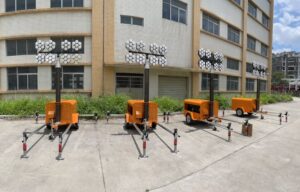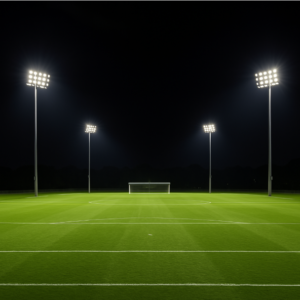Coverage Area
Coverage area refers to the total space or ground that the lighting system can adequately illuminate. The size of the coverage area depends on several factors, including the number of lights, the wattage of the lights, and the height of the mast.

Key Considerations for Optimal Lighting Performance
In summary, lighting uniformity and coverage area are essential factors for ensuring optimal performance, safety, and visibility. Mobile light towers, with their adjustable features and high-powered LED lights, offer an excellent solution for achieving uniform illumination across large outdoor areas while maximizing energy efficiency.
One of the standout features of mobile light towers is their ease of movement and positioning, which makes them ideal for optimizing lighting angles and coverage in various outdoor settings.
Portability for Versatility
Mobile light towers are designed with portability in mind. Mounted on a trailer-based system, these towers are equipped with wheels and a tow bar, allowing them to be easily transported from one location to another. This design is particularly beneficial for temporary setups, such as sports events, construction sites, or emergency situations where lighting needs may vary or change frequently. The ability to move the tower quickly and efficiently ensures that lighting can be adjusted based on the specific needs of each event or project.
Adjustable Positioning for Optimal Lighting Angles
The height-adjustable mast on mobile light towers plays a critical role in providing the flexibility to direct light precisely where it is needed. By raising or lowering the mast (often up to 20 meters), the operator can adjust the lighting angle to cover specific areas of the venue. Whether it’s focusing the light on a particular section of a soccer field, illuminating a construction site at a certain angle, or adjusting for a different event layout, the mobile light tower offers unparalleled flexibility in positioning.
Additionally, many mobile light towers feature adjustable LED fixtures, allowing for fine-tuning of the light direction, ensuring uniform coverage and reducing glare or shadows in unwanted areas. This feature is especially useful for providing targeted illumination in applications such as:

Ease of Setup and Breakdown
Thanks to their portable and user-friendly design, mobile light towers can be set up and positioned quickly, allowing for fast deployment of lighting in dynamic environments. Once the event or work is completed, the tower can be easily repositioned or broken down for transport to the next location. This efficiency reduces setup times, helps meet tight event schedules, and improves overall operational efficiency.
Enhanced Control Over Lighting Coverage
The ability to move and reposition the tower also means that the coverage area can be continuously adjusted throughout an event. For example, if a soccer match shifts focus to a different section of the field, the light tower can be repositioned to provide optimal coverage. Similarly, the flexibility in positioning ensures that uneven lighting or shadows are minimized, improving both player visibility and fan experience.
In conclusion, the easy mobility and adjustable positioning of mobile light towers make them an ideal solution for delivering customizable, high-performance lighting in a wide range of outdoor applications. This flexibility ensures that users can always achieve the best possible lighting angles and coverage, enhancing the effectiveness and efficiency of their lighting setup.
Mobile light towers are ideal for temporary setups such as tournaments, practice sessions, and events, offering flexibility, portability, and quick deployment. Here’s how these features make them the perfect lighting solution for such applications:
Portability for Quick Setup and Relocation
Mobile light towers are designed to be easily transported, making them highly effective for temporary setups where lighting needs to be moved or adjusted quickly. Whether it’s for a sports tournament or an outdoor concert, these towers can be transported to the location, set up, and ready for use in a fraction of the time it would take to install permanent lighting solutions. Their trailer-based system and wheels allow them to be easily moved around the venue, positioning the lights where they are needed most.
Adjustable Height and Direction for Different Needs
The ability to adjust the height of the mast (up to 20 meters) provides the flexibility to tailor the lighting based on the specific requirements of the event. For example:
Cost-Effective and Time-Saving Solution
Because mobile light towers are designed for temporary use, they are more cost-effective than installing permanent lighting systems for short-term events. They eliminate the need for extensive infrastructure investments, making them the preferred choice for temporary lighting. Moreover, mobile light towers require minimal setup time and can be quickly packed up and moved to another venue once the event is over, saving time and money for event organizers.
Flexibility for Multiple Event Types
Mobile light towers are not limited to just one type of event; they can be used in a wide variety of settings, making them a versatile lighting solution for temporary events, such as:
Energy Efficiency and Environmentally Friendly
Mobile light towers are equipped with LED lights, which consume significantly less energy compared to traditional lighting technologies. This makes them an environmentally friendly option for temporary events, as they reduce both energy costs and the carbon footprint of the event. Additionally, with a long lifespan and minimal maintenance, LED-equipped mobile towers ensure that operational costs remain low throughout their use.
Reliable and High-Quality Illumination
Mobile light towers deliver consistent, high-quality illumination with uniform lighting across the field or venue. This ensures that participants, whether athletes or event-goers, have optimal visibility, no matter the lighting conditions. The ability to adjust the light levels and coverage area means that the system can be tailored to meet the needs of any specific event.
In summary, mobile light towers are the perfect solution for temporary setups due to their portability, versatility, energy efficiency, and ease of use. Whether for sports tournaments, practice sessions, or large outdoor events, these lighting systems offer high-performance illumination with the flexibility to adapt to a wide variety of needs, making them an invaluable tool for organizers.
that’s one of the key benefits of LED technology, especially when compared to traditional lighting systems like halogen or metal halide lights. LEDs offer a higher luminous efficacy, meaning they produce more light per watt of energy consumed. This results in lower energy consumption while maintaining high brightness levels, making them ideal for applications like soccer field lighting where bright, even illumination is essential.
Additionally, LEDs tend to have a much longer lifespan than traditional lighting options, which further reduces operational costs due to fewer replacements and less maintenance.
(To Be Continued)
Get in touch for free lighting customization